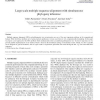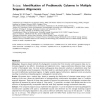30 search results - page 3 / 6 » The Performance of Neighbor-Joining Methods of Phylogenetic ... |
PROCEDIA
2010
13 years 2 months ago
2010
The field of bioinformatics is witnessing a rapid and overwhelming accumulation of molecular sequence data, predominantly driven by novel wet-lab sequencing techniques. This trend...
BMCBI
2007
13 years 7 months ago
2007
Background: Overlapping genes (OGs) in bacterial genomes are pairs of adjacent genes of which the coding sequences overlap partly or entirely. With the rapid accumulation of seque...
JPDC
2006
13 years 7 months ago
2006
Multiple sequence alignment (MSA) and phylogenetic tree reconstruction are one of the most important problems in the computational biology. While both these problems are of great ...
IPPS
2007
IEEE
14 years 1 months ago
2007
IEEE
Bayesian phylogenetic inference is an important alternative to maximum likelihood-based phylogenetic method. However, inferring large trees using the Bayesian approach is computat...
ALMOB
2008
13 years 7 months ago
2008
Motivation: Sequence-based methods for phylogenetic reconstruction from (nucleic acid) sequence data are notoriously plagued by two effects: homoplasies and alignment errors. Larg...


